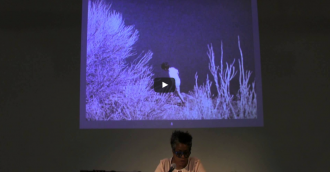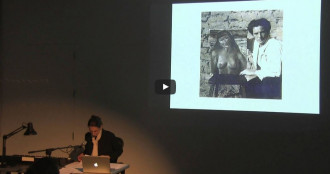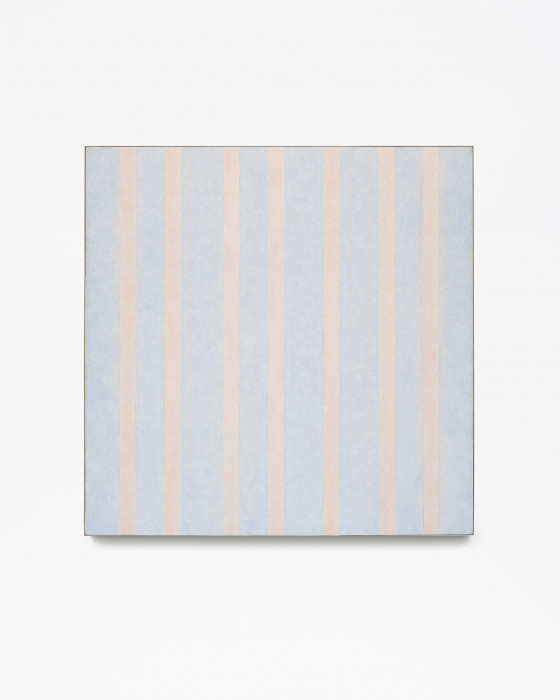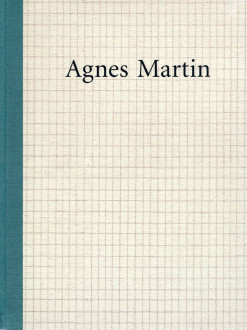Agnes Martin: To the Islands: Paintings 1974-79
December 2, 2005–June 26, 2006, Dia Beacon
Overview
The third in a five-part series of presentations of Agnes Martin’s work, “To the Islands” highlighted Martin’s paintings from 1974 to 1979.
In 1967, Martin left New York City, where she had lived and worked since 1957. She settled in a remote area in New Mexico, where she built a small house, then a studio. Following the first retrospective of her work (at the Institute of Contemporary Art in Philadelphia in 1973) and her reexamination of her practice via a print portfolio and the publication of her early writings, Martin began to paint again in 1974.
The paintings of the period 1974 to 1979 explore new avenues within Martin’s aesthetic, while retaining the format of the 6-foot-square canvas, which she privileged during the 1960s. During the years 1974–75 Martin introduced a more radiant use of color and an interest in seriality. “To the Islands” included The Islands (1979), a suite of paintings in diluted washes of acrylic and graphite, each a subtle variation on a white-and-light-blue composition with overlaying graphite lines. A single work in twelve parts, this monumental painting is among Martin’s most ambitious works. Among the other paintings on view in “To the Islands” were Untitled #12, an India ink, graphite, and gesso canvas featuring large bands of subtle washes in pale blue and salmon pink.
“To the Islands” was followed in summer 2006 by a fourth component dedicated to works from the 1980s.
In 1974 Agnes Martin resumed painting after a hiatus of some six years. During that interval, she had relocated from New York City, where she lived from 1957 to 1967, to a remote mesa in New Mexico, where she built herself a small house, then a studio. And, for the first time in public, she undertook a retrospective examination of her practice: a threefold enterprise that comprised a print portfolio, an exhibition, and writings.
To serve as the template for the suite of thirty serigraphs, Martin created a group of some thirty drawings, based on her own drawings from the previous decade. Titled On a Clear Day (1973), these prints mechanically reproduce in precise detail the spare linear grids on neutral monochrome grounds that had become a hallmark of her mature vocabulary, a vocabulary in which drawing was unequivocally the privileged medium. 1973 also marked the first retrospective of her work, at the Institute of Contemporary Art in Philadelphia. With some 37 paintings and 21 drawings, this substantial show surveyed in detail the finely nuanced shifts and subtle variations Martin had assayed within her rigorously pared idiom over the decade 1957 to 1967. The accompanying catalogue contained a series of statements and notes in which she articulated the principles of her vision of an art and life predicated on the search for perfection, beauty, and happiness. Here Martin laid the groundwork for future critical interpretation, limning a metaphysic that evolved from her dialogue with the work of the three Abstract Expressionists to whom she felt most closely aligned: Barnett Newman, Mark Rothko, and Ad Reinhardt. Such writings and interviews would not only inflect and shape subsequent appreciation of her art but also provide the basis for the media's construction of her artistic persona: the image of an exemplary artist, even a role model, whose deep commitment to her work required extended periods of solitude and the renunciation of materialist rewards as prerequisites to a highly disciplined search for an "untroubled mind."
The paintings that emerged in 1974 after this period of relocation and stocktaking betray both close relations with works she had made in the mid-sixties as well as significant shifts in focus. They retain the six-foot-square format, together with a rigorous linear scaffold plotted in fine graphite, which she had long employed. But she now dispensed with monochrome fields in favor of bands, blocks, and stripes of radiant color, in pale washes of blue and various pinks, peaches, and salmons laid over intense white grounds. And, as seen in Untitled #8 (1974), white is treated as one color among others: here it serves as a luminous armature that holds in delicate equipoise alternating bands of color, a framing device whose slightly broader top and bottom borders temper the vertical white "zip," which at once bisects and sutures the parallel planes of pink and blue. The clear effulgent color in the paintings of 1974-75 is gently harnessed by, and to, the crisply stated graphite lines; in this way, Martin again achieves the tenuous balance-between the material and immaterial, the literal and illusory, the precise and the inchoate, the sensuously opulent and the austere-that characterizes key works of the previous decade. Whether employing horizontally or vertically oriented stripes and bands, symmetrical or asymmetrical compositions, or one or two hues in addition to white in her palette, these mid-seventies paintings, like earlier works, neither reveal themselves immediately nor require protracted close scrutiny. Instead, they invite a slowed-down mode of looking, a quieting of one's normally active gaze in order to attend to the coloristic harmony that generates a particular light, in a painting conceived as a single entity in vibrant repose rather than a composite whole, an amalgam of parts, or a sequence of events.
Light had occupied Martin intermittently during the sixties, evidenced most overtly in Friendship (1963), where she incised a grid into a surface made from gold leaf. Elsewhere, color becomes light's servant-the atmospheric roseate veil in Flower in the Wind (1963), the skein of crimson lines that generates a tremulous blush in Red Bird (1964), or the grid of red and green pencil lines that creates an elusive vibrant shimmer in Garden (1964). But line, as tone, could also be pressed into service, as in The Harvest (1965), where a delicate graphite sheath creates a tenebrous penumbra to effect spatial dislocation, or decentering, so that looking becomes, as Briony Fer argues, "a kind of looking for a lost totality."1 "My paintings have neither object nor space nor line nor anything—no forms," Martin had stated in 1966. "They are light, lightness, about merging, about formlessness, breaking down forms."2
In the works of the mid-seventies, when effects of light increasingly prevail over spatial determinations, Martin began to set up serial relations, binding one work to another by loose (as distinct from strictly parsed) compositional permutations. After a brief reprise-a return to restraint via graphite grids superimposed on monochrome grey grounds in the paintings from 1977-her newfound interest in seriality culminated in 1979 in The Islands, a single work in twelve parts.3 Unified by a matte-white tonality, each picture is slightly differentiated from the others by a barely discernable light tint of green or yellow, so that, as Heinz Liesbrock notes, "although the coloration of all the pictures in the group is closely related, no single one is identical in tone with any other."4 Washes of pale bluish grey applied to bands made from fine lines drawn in pencil, either singly or in closely spaced pairs, order the pictorial image. Based on major divisions into four, five, or six zones, then occasionally subdivided by a secondary set of lines, the twelve barely tinted canvases are interrelated through rule, number, and alignment- by near relations as much as subtle displacements; the result is what Martin termed a classic art. "People think that painting is about color [but it's] mostly about composition," she argued in that first considered statement she published on her art in 1973. "It's composition that's the whole thing / The classic image."5 Tellingly, color has here again given way to tone, heralding the reductive approach to a more muted light generated by the opaque pigments she would privilege during the eighties.
A limpid statement unparalleled in Martin's oeuvre in its grandeur and breadth, The Islands bids comparison with those environmentally scaled series that Rothko and Newman created in the sixties, respectively, the Rothko Chapel project in Houston and Stations of the Cross.6 Reinhardt's closely valued black paintings, also ideally presented as an ensemble, are equally relevant; for Martin's encompassing statement similarly requires a dynamic roving from painting to painting. Rarely would she again feel the need to so physically engage the spectator. For the most part thereafter, her endeavor would not be to mobilize the viewer in a process of "looking for" but to immerse the solitary, stationary spectator in an indeterminate, luminous space, in attentive contemplation, "looking at."
Notes
1. Briony Fer, The Infinite Line: Re-Making Art After Modernism (New Haven, Conn.: Yale University Press, 2004), p. 57.
2. Agnes Martin, quoted in Ann Wilson, "Linear Webs," Art and Artists 1, no. 7 (October 1966), p. 49.
3. Scholarly research on Martin's oeuvre is in its infancy, so the following statements may later require qualification. It seems that no paintings are extant from 1976, the year in which Martin focused on making Gabriel, a 90-minute film. There seem also to be no paintings dated 1978 in her oeuvre; and The Islands are the only known canvases attributed to 1979.
4. Heinz Liesbrock, "Figure and Emptiness: Agnes Martin's The Islands at the Josef Albers Museum," in Agnes Martin: The Islands (Düsseldorf: Richter Verlag, in association with Joseph Albers Museum, Quadrat, Bottrop, 2004), p. 38.
5. Martin, "The Untroubled Mind," in Agnes Martin: Writings-Schriften, ed. Dieter Schwarz (Osfildern Ruit, Germany: Cantz, in association with the Kunstmuseum Winterthur, 1991), p. 35. "The Untroubled Mind" was first published in Agnes Martin (Philadelphia: Institute of Contemporary Art, 1973), pp. 17-24.
6. The use of evocative titles is relatively rare in Martin's works after 1967. She had previously used this title, The Islands, for other works, such as the six-foot-square painting, circa 1961, now in the Glimcher collection.
Artist
Agnes Martin
Agnes Martin was born in Macklin, Canada, in 1912. She died in rural New Mexico in 2004.
Books
Agnes Martin
This important anthology brings together the most current scholarship on Agnes Martin's paintings by essayists considering the many facets of the artist's four-decade career.
Explore
Jennie C. Jones on Agnes Martin
Move to Jennie C. Jones on Agnes Martin pageJutta Koether on Agnes Martin
Move to Jutta Koether on Agnes Martin pageVija Celmins on Agnes Martin
Move to Vija Celmins on Agnes Martin pageZoe Leonard on Agnes Martin
Move to Zoe Leonard on Agnes Martin page
Jennie C. Jones on Agnes Martin
Move to Jennie C. Jones on Agnes Martin page

